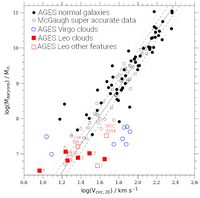The Tully-Fisher Relation
One of the key diagnostics of whether a cloud is likely a galaxy or not is its kinematics, exactly how its constituent parts are moving around in relation to one another. At any given size, the faster the motions, the more mass is required to hold a structure together. Galaxies, notoriously, are defined by rotating so quickly that their visible mass is insufficient to hold them together by its gravity. But with AGES, measuring the exact size is usually difficult since Arecibo had exquisite sensitivity at the cost of resolution. This means quantifying the amount of missing material is challenging.
One technique that can help is to use the Tully-Fisher relation. This is more widely-known as a distance estimator. Tully & Fisher discovered that there's a tight relationship between how fast a galaxy is rotating and its intrinsic optical brightness, which Stacy McGaugh extended to show that this is a relationship between rotation speed and total mass (including the gas, not just the stars). But if you already know the distance, you can see if your object follows the same Tully-Fisher relation as for ordinary galaxies or not. And you don't need to know the physical size of your object for that.
Recently this has become a very active field thanks to the discoveries of "ultra diffuse" galaxies, many of which seem to rotate more slowly than expected. This suggests that they have less dark matter than expected, in a few extreme cases possibly no dark matter at all ! But I noticed that the Virgo dark clouds deviate in the opposite way : they "rotate" (if that's really what they're doing) much faster than galaxies of similar mass.
Interpreting this is, as you've probably guessed, complicated. At any given mass, faster motions indicate more dark matter while slower speeds mean less. But this only applies for stable systems. If we have unstable debris, there's no reason to think they should follow the same relation as for stable, rotation-dominated galaxies. That relation itself is highly controversial, with some people claiming that the scatter is extremely tight to the point of having zero intrinsic scatter (that is, the only scatter we see is due to measurement inaccuracies), while others disagree. The controversy comes about because a low-scatter BTFR is a prediction of modified gravity theories that do away with dark matter, though it's now unclear if this really would be incompatible with the dark matter paradigm or not.
Then I decided the Leo Clouds would also be worth plotting. And quickly found that although my earlier Virgo result was basically correct, doing this accurately was anything but trivial. I describe the full gory details and my emotional, heart-wrenching journey in a post here, but the final plot looks like this :
McGaugh's "super accurate" sample used resolved rotation curves with the galaxies having known distances, so this is an important sanity check that the AGES data has been calibrated correctly. What we see is interesting. The AGES normal galaxies follow the standard BTFR with only a couple of exceptions, likely just bad measurements. For the Leo clouds the situation is all over the place :
- All of the features which have excessive velocities (cloud 1, the candidate cloud 7, and the feature near NGC 3384) are likely tidal debris. Well, that's good so far...
- For the clouds within the general scatter of the normal BTFR the situation is mixed. Cloud 4 and Leo Dwarf A may be normal galaxies and have optical counterparts. Clouds 2 and 3, and the feature 5R (part of the Leo Ring near cloud 5) are likely tidal debris. Cloud 6 is a dark galaxy candidate.
- Cloud 5, which may be an outlying part of the Leo Ring, has a lower velocity width than the standard BTFR.
What this all means, then, is hard to say. There are no clear examples in this sample of genuine galaxies with excessive velocity widths, though we know of plenty with lower velocities. But following the BTFR velocities doesn't guarantee that something is a galaxy either ! And the situation gets still more complicated because the BTFR has been shown to change slope at the very low masses we're dealing with here – correcting for this introduces yet more adjustments. It's all very messy. The exact usefulness of the BTFR as a galaxy-diagnostic tool is, I suggest, still something of an open question.
